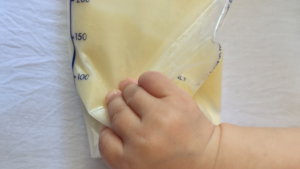
It can be alarming the first time you pump an odd colored breastmilk! Did you know that breastmilk can come in a RAINBOW of hues? It can – and it’s totally normal!
But maybe you’re wondering why this happens. Seeing expressed milk any color other than the white we see sold in the grocery store can be a shock. The truth is that breastmilk can run a gamut of colors and hues. It is actually alive, containing living cells transferred from milk producers to milk consumers.
But what does it mean? Why is it a certain color? And most importantly, is it OK for my baby?
The most common breastmilk colors are white, yellow, and bluish. Depending on your baby’s needs, your milk can go between these colors even during the same pumping or nursing session. Unlike formula which has a set nutritional value, breastmilk does not. Your body will make up the nutrition as it responds to baby’s needs, meaning from session to session the nutritional make-up, like calories, fat, and sugars, will change – but the quantity of milk (how much is consumed or expressed) may not.
Red, brown, or pink milk is typically the combination of your breastmilk mixed with blood. This can happen because of increased blood flow to the breast when nursing or perhaps a cracked nipple is the culprit. No matter the source of the blood, this milk is safe for consumption. It should be noted that, if the milk turns pink AFTER pumping, this milk should not be consumed and you should consult your doctor.
Green milk is probably one of the more shocking colors to discover. If you are on an iron supplement, your milk can mimic the colors of a green smoothie. Speaking of which, if you find yourself on an increased kick of consuming dark leafy greens, this too could change the milk to a green hue.
Other breastmilk colors are often a result of consuming an excess of a natural or artificial color. Drinking blue Gatorade? Milk can take on a stronger blue hue. Made a delicious pot of carrot bisque that your family didn’t take to, so you’ve been indulging? Milk may take on an orange hue. All of these are safe for baby to consume.
One thing to keep in mind is that milk changes color all the time, even when baby is nursing straight from the source. So the likelihood that a chest fed baby had already consumed some colorful nutrition is fairly high. I know it feels different to bottle feed colorful milk, but maybe knowing that it’s already happened a time or two can help the anxiety over it. The visual can definitely be a mix of emotions.
Written by: Lyn Statler



Leave A Comment